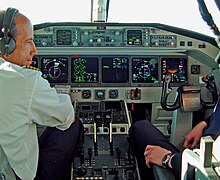Engine-indicating and crew-alerting system
An engine-indicating and crew-alerting system (EICAS)[1] is an integrated system used in modern aircraft to provide aircraft flight crew with instrumentation and crew annunciations for aircraft engines and other systems. On EICAS equipped aircraft the "recommended remedial action" is called a checklist.






Components
editEICAS typically includes instrumentation of various engine parameters, including for example speed of rotation, temperature values including exhaust gas temperature, fuel flow and quantity, oil pressure etc. Other aircraft systems typically monitored by EICAS are for example hydraulic, pneumatic, electrical, deicing, environmental and control surface systems. EICAS has high connectivity & provides data acquisition and routing.[2]
EICAS is a key function of a glass cockpit system, which replaces all analog gauges with software-driven electronic displays. Most of the display area is used for navigation and orientation displays, but one display or a section of a display is set aside specifically for EICAS.
The crew-alerting system (CAS) is used in place of the annunciator panel on older systems. Rather than signaling a system failure by turning on a light behind a translucent button, failures are shown as a list of messages in a small window near the other EICAS indications.
Alternative systems
editSome alternatives are:
- Electronic Centralised Aircraft Monitor (ECAM) on Airbus
- Centralized Fault Detection System (CFDS) on McDonnell Douglas
- Flight Warning System (FWS) on Fokker
- Engine Warning Display (EWD) on ATR
- Комплексная система электронной индикации и сигнализации (КСЭИС) on Antonov.
Presence
editThe system is called EICAS at least on the following aircraft:
Jetliners
editThe first Boeing airliner with EICAS was the Boeing 757. The Boeing 747 has EICAS since the 747-400. No version of the Boeing 737 has EICAS. The Boeing 717 has CFDS, as it was originally a McDonnell Douglas product.
The Embraer ERJ family and the Embraer E-Jet family have EICAS.
The Bombardier CRJ and the Bombardier CSeries have EICAS.
The Fairchild-Dornier 328JET has EICAS.
The COMAC ARJ21 and the COMAC C919 have EICAS.
Turboprop airliners
editThe Saab 2000 has EICAS.
The Dornier 328 and the Dornier 228NG have EICAS.
The Xi'an MA60 and the Xi'an MA600 have EICAS.
Limitations
editOn some Bombardier aircraft, it is possible to call up the wrong checklist. Messages forbidding take-off can be shown as advisories.[3]
The 757, 767, and 747-400 have no electronic checklists.
The ERJ and the E-Jets have no electronic checklists.
The CRJ have no electronic checklists.
The Do-328 and the Do-328JET have no electronic checklists.
The Saab 2000 has no electronic checklists.
Gallery
edit-
EICAS of a Boeing 787 at the center-left
-
EICAS of a Boeing KC-46 at the center-left
-
EICAS of a Boeing 767-400 at the center
-
EICAS of a Boeing 767
-
EICAS of a Boeing 757 at the center
-
EICAS of a Boeing 747-8 at the center
-
EICAS of a Boeing 747-400 at the center
-
EICAS of an Embraer C-390 at the center-right
-
EICAS of an Embraer ERJ
See also
edit- Electronic centralised aircraft monitor, a similar system by Airbus
References
edit- ^ Wells, Alexander T.; Rodrigues, Clarence C. (2004). Commercial aviation safety (4th ed.). McGraw-Hill Professional. p. 245. ISBN 978-0-07-141742-6.
- ^ "EICAS displays". Astronautics. Astronautics Corporation of America. Archived from the original on 2011-07-07. Retrieved 2020-12-03.
- ^ Gilbert, Gordon. "Multiple EICAS Alerts Preceded Fatal Challenger In-flight Upset - AIN". Aviation International News.
- ^ https://www.collinsaerospace.com/what-we-do/industries/commercial-aviation/flight-deck/integrated-systems/flight-deck-retrofits/large-display-system [bare URL]
External links
edit- Astronautics Corporation of America EICAS displays (Archive)